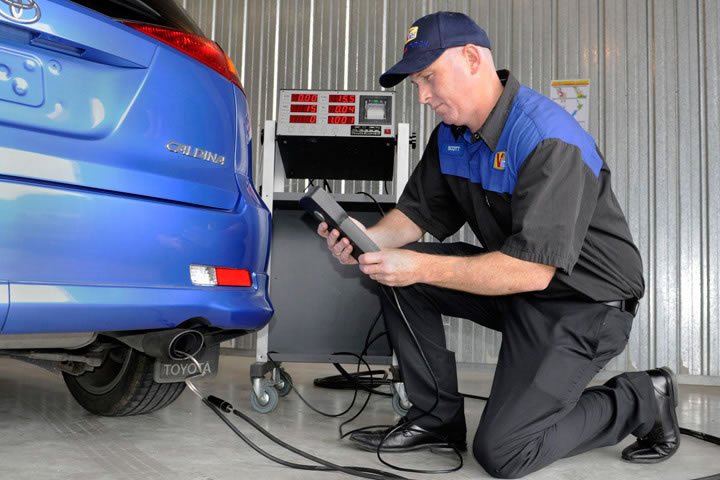Texas Emissions Inspection & Smog Laws
In Texas all vehicles must go through safety inspection once a year. This safety inspection includes emissions inspection, or otherwise known as “smog” inspection.
The following article will give you the basics of smog laws in Texas. Below you can find out how smog checks are performed in this state, and which vehicles can be exempt from the laws.
When are emissions inspected?
All vehicles registered in TX must get a safety inspection every 12 months. Emissions testing is done during the safety inspection.
Which vehicles require emissions testing?
Your vehicle requires emissions test if:
- It’s between 2 and 24 years old
- If it runs on gasoline
Which vehicles are exempt from smog testing?
Diesel-powered vehicles or those newer than 2 or older than 24 years are exempt from smog check. Motorcycles are also not undergoing emissions testing. Further exempt vehicles include:
- Road-Building Equipment.
- Farm Machinery.
- Trailers, semitrailers, pole trailers and mobile homes with a registered gross weight of 4,500 pounds or less.
- Any vehicle that is required to display a Slow-Moving Vehicle emblem.
- Any vehicle with a special license such as a parade license, in-transit license, machinery license, disaster license, farm trailer license, permit license, antique license, charitable organization tag or ATV validation sticker.
- A vehicle with a Texas permit such as a factory delivery permit, prorate tab, one-trip permit or temporary permit.
- Mobile drilling and servicing equipment used in gas, oil, or crude production with a 72 hour or 144 hour permit.
Which counties or areas require smog test?
Testing for vehicle emissions is not required in all of Texas. The following 17 counties require smog tests for eligible vehicles:
- Brazoria
- Fort Bend
- Galveston
- Harris
- Montgomery
- Collin
- Dallas
- Denton
- Ellis
- Johnson
- Kaufman
- Parker
- Rockwall
- Tarrant
- Travis
- Williamson
- El Paso counties
How emissions testing works?
To complete your vehicle safety inspection visit your nearest licensed inspection station with your ID, vehicle registration, proof of insurance, and payment fee.
Your vehicle will receive either OBDII (On-Board Diagnostic II) testing if it’s newer than 1996, or TSI (Two Speed Idle) or ASM (Accelerated Simulation Mode) test if it’s 1995 or older model.
Assuming your vehicle passes both safety and smog emissions inspections, you will receive documentation required for your vehicle registration or registration renewal. You will also receive a windshield sticker serving as proof.
Which emissions control devices are tested?
Assuming your vehicle was originally manufactured with them, the following emissions control devices are tested during emissions testing:
- Catalytic converter (CAT)
- Exhaust gas recirculation valve (EGR)
- Positive crankcase ventilation system (PCV)
- Air injection system (AIS)
- Evaporative emissions control (EVAP)
- Fuel inlet restrictor (FIR)
- Thermostatic air cleaner (TAC)
What happens is emissions testing fails?
Failing emissions testing means your vehicle will have to be repaired and re-tested before you can pass the safety inspection.
Ensure you find a Recognized Emissions Repair Facility of Texas to complete any emissions repairs. When repairing in non-recognized repair stations labor costs will not be contributed to waiver requirements, only vehicle parts.
What if repairs fail?
If your vehicle does not meet emissions or smog standards set by Texas laws, you can apply for a waiver or have your vehicle repaired.
These waivers can be granted to low-income individuals. A one-year extension is added to anyone who’s annual income is below national poverty level. The national poverty level (also known as Federal Poverty Guidelines) are updated annually. For 2025, the poverty guideline for a single person is $15,650.
Motorists who drive less than 5,000 miles per year can also qualify for exemption from Texas smog laws, but must first spend at least $100 for emissions-related repairs.
Other possible waivers can be issued when required vehicle parts are not readily available for purchase, or when owner spends over $600 for emission-related repairs but still fails smog inspection.
See more on:
- Texas DPS – Extensions and waivers
- Texas Commission on Environmental Quality (TCEQ) – Affidavit, Waivers and Extensions, and the Vehicle Inspection Report
How much are emissions testing fees?
Depending on your county, emissions testing fee is added to safety inspection fee. Typically this fee is no higher than $40. See Texas Commission on Environmental Quality for an overview of applicable fees.
Don’t forget to keep your receipt when you pass safety and emissions inspection. This will serve as proof of your completed inspection and you may require it at a later date.
Please note we only provide this information about vehicle emissions for informational purposes. You should always double-check current and official Texas smog laws and regulations to ensure this information is correct.
Sources & references:
- Texas Department of Public Safety – Vehicle Inspection: information & overview
- Texas Department of Public Safety – Vehicle Inspection Criteria
- Texas DPS – Waivers and time extensions
- Texas Commission on Environmental Quality (TCEQ) – Affidavit, Waivers and Extensions, and the Vehicle Inspection Report
